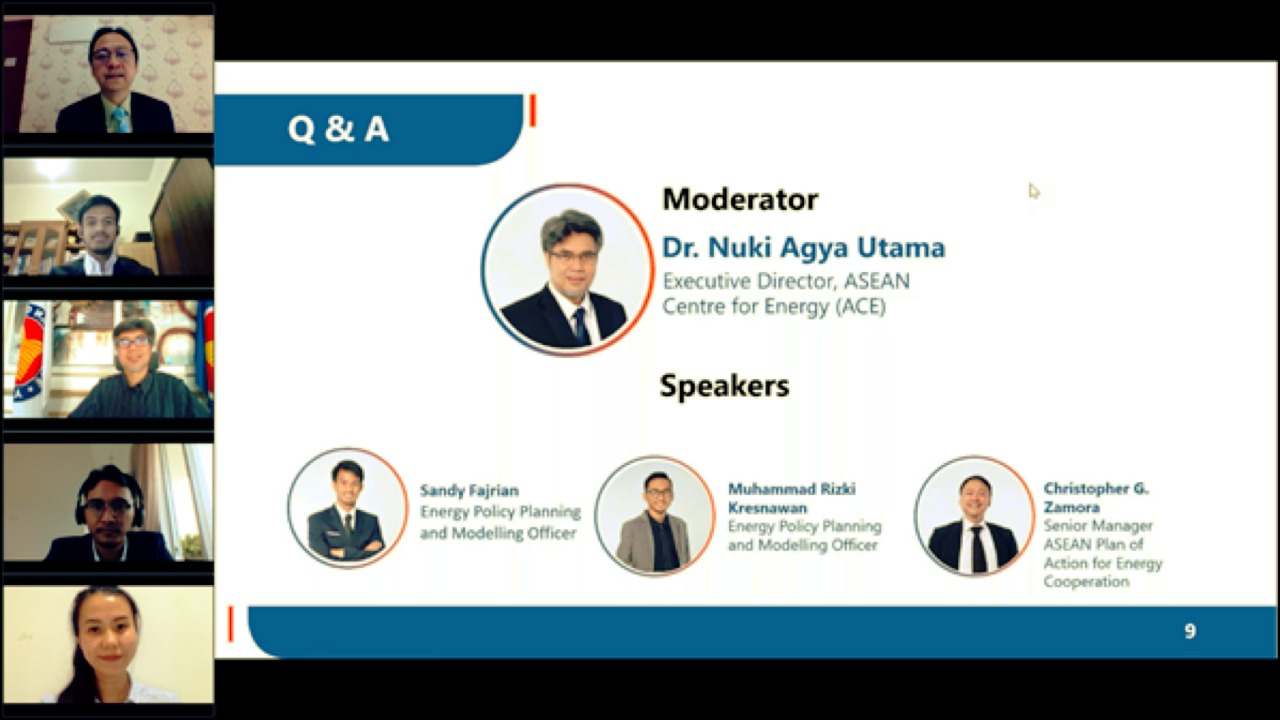Menu
Online, 16 March 2021Reflecting on the ASEAN Plan of Action and Energy Cooperation (APAEC) Phase II: 2021-2025 and the 6th ASEAN Energy Outlook (AEO6), which were proposed on the 38th ASEAN Ministers on Energy Meeting (AMEM) held virtually in Vietnam on November 19th, 2020, ASEAN Centre for Energy (ACE) held a webinar to disseminate the importance of APAEC and AEO6 as manuals for ASEAN member states (AMS) to pursue sustainable future.
The event was held on March 16th, 2021, moderated by the Executive Director of ACE, Dr Nuki Agya Utama. ACE’s Energy Policy Planning and Modelling Officers, Mr Sandy Fajrian and Mr Muhammad Rizki Kresnawan, as well as Senior Manager of APAEC, Mr Christopher G. Zamora, joined as speakers of the event.

As main objectives, AMS have agreed on increasing renewable energy (RE) share in power plant to 23% in Total Primary Energy Supply and 35% share of RE in ASEAN installed power capacity by 2025. Besides, they also targeted a reduction of energy intensity by 32% in 2025. Phase II has just begun, marking an important effort toward a sustainable future.
ASEAN, as a unifying entity of 10 Member States, should continue to stress the importance of harmonious planning throughout all states. It is important to respect each other’s national goals and individuality, but under the energy sector, effort on pursuing a single goal should be put into action. Mr Fajrian mentioned that after the comprehensive research, by following a common target, expenditure on energy could be saved up to 30%. It is larger compared to 22% if each member states follow their own. Achieving the target is an issue that requires huge effort and coordination, but the result will be desirable.
Several real-life energy-related issues are extremely close to our activity. For example, the ownership of private transportation contributes to 23% greenhouse gases, 26% total final energy consumption, and 80% gasoline and diesel consumption. As household income increases, society’s buying power also increases. If it is not handled by alternative solutions, such as efficient public transportation and, electric/hybrid vehicle, the figures will keep increasing, as Mr Kresnawan explained during his presentation.
Furthermore, ASEAN countries are prone to humid warm weather due to their geographical location. The importance of air conditioning at an indoor location is not subject to compromise. It is expected soon that the air-conditioned room will increase. Therefore, from now on, robust regulations are required to tackle the issue at an early stage.
Another issue is to expand cleaner cooking in rural areas in ASEAN. The smoke that is produced by wood or charcoal will damage the atmosphere and cause respiratory problems. A proposed solution is to utilise biogas as an affordable and cleaner alternative for those who have limited access.
As the Senior Manager of APAEC, Christopher G. Zamora has actively engaged to plan and implement the outcome-based strategies (OBS) on APAEC Phase II. During the 38th AMEM, all ministers have pledged to continue transitioning ASEAN towards sustainable energy in the future. They agreed on accelerating the current rate of transition as well. During the meeting, 32 OBS, 100 action plans, and 346 annual milestones were discussed and planned for the execution for all seven (7) programme areas: (1) ASEAN Power Grid, (2) Trans-ASEAN Gas Pipelines, (3) Coal and Clean Coal Technology, (4) Energy Efficiency and Conservation, (5) Renewable Energy, (6) Regional Energy Policy and Planning, and (7) Civilian Nuclear Energy.
Increasing demand and common interests for cleaner energy throughout the world have led to more intensive coordination between countries. AMS has also agreed to join the movement by engaging with Dialogue Partners (DPs) and International Organisations (IOs) to share ASEAN’s vision of a sustainable future. Information and data sharing across AMS serve as important tools for planning a more comprehensive policy. Supported by thorough analysis, knowledge sharing will increase opportunities for AMS to implement the most proper solution for energy matters.
Wrapping up each speakers’ presentation, audiences had the opportunity to interact during questions and answers session. A question arose whether achieving a 23% share of RE within AMS was possible. Mr. Zamora believed that it took enormous effort to achieve consistent results throughout AMS. It would require 1% of regional GDP which is a huge share, but there is a good hope by other means, which is the ASEAN interconnection masterplan study.
Other participant asked about stakeholders that will fund the RE shares in ASEAN. Mr. Fajrian said that all stakeholders were important, including the banking sector which will be responsible for RE financing. Since there were risks in the RE-related projects, capacity building and government incentives could support the development of RE investment.
Afterwards, a question was raised about countries that had energy cooperation with ACE in handling Sustainable Development Goals (SDG) 7: Affordable and Clean Energy. According to Mr Kresnawan, all AMS was keeping in contact with each other on coordination and data sharing that will be needed for the SDG7 scenario, since it is a crucial theme for the AMS. One of the projects is the ASEAN Climate Change and Energy Project (ACCEPT) which was funded by the Norwegian Embassy and involved 20 national focal persons from all AMS in the energy sector as well as the environment.
Dr Utama wrapped up the entire session, stating that regional cooperation and engagement with DPs, IOs, the private sector, and academia were the key success factors of APAEC Phase II. Particularly, attracting investments in the energy sector in the following five years and promoting the active participation of private sectors.
(TA/HHS)
